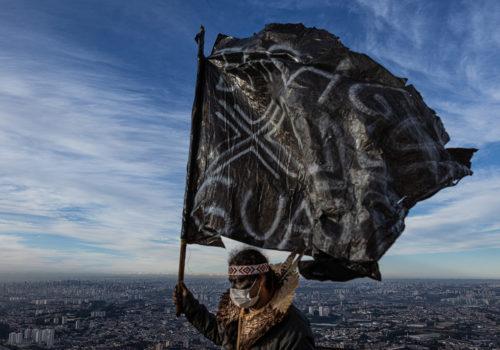This month, I met with Karin Rehn-Kaufmann, who is in charge of the entire photo art section at Leica Camera Deutschland, managing relations between galleries, artists, and cooperation partners. You can also find her in various juries and on different boards when it comes to photography prizes. In this interview, I learned more about her job and what’s new.
Nadine Dinter: What does photography mean to you?
Karin Rehn-Kaufmann: Photography has been a big part of my life for a long time. I love looking at pictures, talking with photographers about their work, and curating exhibitions.
Do you have a photographic background?
KRK: No, I was a teacher before founding my own Leica Gallery in Salzburg in 2008. But photography has always fascinated me, and this passion has led me to learn all I can about it over the years.
As Art Director & Chief Representative of Leica Galleries International, you are responsible for all of the photography exhibitions at some 30 Leica galleries worldwide. Do you have a concept for rotating shows, or does each gallery have its own individual exhibition schedule?
KRK: There are currently 26 Leica Galleries around the world. They often show traveling exhibitions, which are stored at Leica HQ. These include showcases of works by Steve McCurry, Thomas Hoepker, and Bruce Davidson, for example. The galleries also exhibit our Leica Oskar Barnack finalists and winners. But it is equally important that each gallery seeks good photographers in their own country, especially young talents.
Which photo exhibition has been the most successful since the first Leica Gallery opened?
KRK: The question is, what do you mean by successful – lots of visitors or lots of sales? The two don’t always go hand in hand. I can name many successful shows, like Bryan Adams, Till Brönner, Lois Hechenblaikner, and Elliott Erwitt, to name just a few.
Do you see a difference in the audience’s response to shows by classic, professional photographers compared to shows by artists who first found success in a different career before turning to photography?
KRK: It’s always about the quality of the images. That’s what Leica stands for. Many good photographers later turned their passion for photography into a profession. I don’t see a difference in the audience.
Who would you choose if you could organize an exhibition with any of the current and past Leica photographers, even icons like Newton, Avedon, or Penn?
KRK: Henri Cartier-Bresson.
Leica photography is known for its street photography, portraiture, and reportage; are there other genres where Leica would like to strengthen its roster and be more present?
KRK: I think Leica should be more present in fashion and art photography.
This October, the winners of this year’s renowned Leica Oscar Barnack Award were announced. What is the story behind the prize, and what does it stand for?
KRK: The Leica Oskar Barnack Award (LOBA) is a great passion of mine. It is one of the oldest and most famous photo competitions. It was first awarded in 1979, commemorating the 100th anniversary of the birth of Oskar Barnack, the inventor of the first compact 35 mm camera. Since then, the annual award has always had the same topic: showing the relationships between people and their environment. The prize focuses mainly on documentary and reportage series comprising 25 images or more. Even in the face of challenging world events, photography has the power to give reason for hope: Don’t look the other way, shake things up, express and advocate for change – the connection to humanity and our responsibility to bear witness to its moments is at the heart of Leica’s culture – from the Leica Oskar Barnack Award to all our Leica Galleries. With these initiatives, we recognize and celebrate courageous visual storytelling.
Past LOBA winners include Sebastião Salgado, Jane Evelyn Atwood, Jan Grarup, Dominic Nahr, and Luca Locatelli. Receiving the prize has always been a significant boost in a photographer’s career. Not only do we support them with camera equipment and money. We feature the work of the finalists (usually around 10) and the two winners (main category and newcomer) in a huge exhibition at our Ernst Leitz Museum in Wetzlar, Germany. The “Leica Oskar Barnack Award – The Winners and All Finalists” is a major annual event that brings together people from all over the world. We also produce a dedicated LFI LOBA Magazine. The exhibition then travels to festivals and Leica Galleries worldwide – our winners get a lot of visibility.
What’s in store for 2023? Any highlights you want to share with the readers?
KRK: In 2023 we will open new Leica Galleries in Mexico City, New York, Paris, and Amsterdam. And we will have great exhibitions showcasing the work of Swiss photographer Alberto Venzago and Canadian photographer and musician Bryan Adams at our Ernst Leitz Museum.
What makes a good photo curator?
KRK: A good curator looks at the work and then decides what they need. What is the best way to present the images? How should they be produced – mounted on Dibond, framed, or PPT? What color should the walls be painted to complement the series? What kind of hanging suits the message of the images? As a curator, you do what is in the best interest of the photographs.
“Leica Oskar Barnack Award – The Winners and All Finalists” exhibition
Ernst-Leitz-Museum, Wetzlar
21 October 2022 – January 2023
https://www.leica-oskar-barnack-award.com/
















